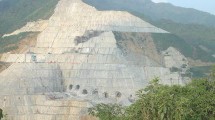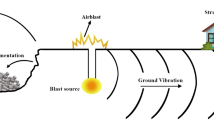Abstract
This research proposes a novel bee colony optimized support vector classifier (BeeSVC) for predicting typhoon-induced slope collapses. The BeeSVC employs the support vector classifier (SVC) as a machine learning method to classify a slope into two classes: “stable slope” and “collapsed slope.” Furthermore, the artificial bee colony algorithm is used as a metaheuristic to determine the hyper-parameters of the SVC appropriately. The contribution of the proposed method to the body of knowledge is multifold. First, the combined framework of the BeeSVC allows the assessment process to be operated automatically. Second, since the number of the “collapsed” class occupied more than 70 % of the historical cases, a repeated random sub-sampling procedure with the Student’s t test is put forward to alleviate the class-imbalanced problem and reliably evaluate the model performance. Third, the mutual information between the input features and the slope performance is employed to reflect the contribution of each feature to the slope failure. Lastly, the superior performance has proved that the BeeSVC can be a very effective tool for decision-makers to forecast typhoon-induced slope collapses.



Similar content being viewed by others
References
Alpaydın E (2010) Introduction to machine learning, 2nd edn. The MIT Press, Cambridge
Battiti R (1994) Using mutual information for selecting features in supervised neural net learning. IEEE Trans Neural Netw 5(4):537–550
Bishop C (1995) Neural networks for pattern recognition. Clarendon Press, Oxford
Bradley AP (1997) The use of the area under the ROC curve in the evaluation of machine learning algorithms. Pattern Recogn 30(7):1145–1159
Chen SZ, Hu LJ, and Chen GH (1988) The investigation and remedy on the slope failure of Mt. So-San. Hazard Mitigation Report No. 77-12, National Science Council, Taiwan, Republic of China
Chen M-Y, Chen C-C, Liu J-Y (2013) Credit rating analysis with support vector machines and artificial bee colony algorithm. In: Ali M, Bosse T, Hindriks K, Hoogendoorn M, Jonker C, Treur J (eds) Recent trends in applied artificial intelligence. Springer, Berlin, pp 528–534
Cheng M-Y, Hoang N-D (2014a) Groutability prediction of microfine cement based soil improvement using evolutionary LS-SVM inference model. J Civ Eng Manag 20(6):1–10
Cheng M, Hoang N (2014b) Groutability estimation of grouting processes with microfine cements using an evolutionary instance-based learning approach. J Comput Civ Eng ASCE 28(4):04014014
Cheng MY, Ko CH (2003) Automated safety monitoring and diagnosis system for unstable slopes. Comput Aided Civ Inf 18(1):64–77
Cheng M-Y, Wu Y-W, Chen K-L (2011) Risk preference based support vector machine inference model for slope collapse prediction. Autom Constr 22:175–181
Cheng M-Y, Hoang N-D, Limanto L, Wu Y-W (2014) A novel hybrid intelligent approach for contractor default status prediction. Knowl Based Syst 71:314–321
Ching J, Liao H-J, Lee J-Y (2011) Predicting rainfall-induced landslide potential along a mountain road in Taiwan. Geotechnique 61(2):153–166
Dibike Y, Velickov S, Solomatine D, Abbott M (2001) Model induction with support vector machines: introduction and applications. J Comput Civ Eng ASCE 15(3):208–216
Ferentinou MD, Sakellariou MG (2007) Computational intelligence tools for the prediction of slope performance. Comput Geotech 34(5):362–384
Goh ATC, Goh SH (2007) Support vector machines: their use in geotechnical engineering as illustrated using seismic liquefaction data. Comput Geotech 34(5):410–421
Hagan MT, Menhaj MB (1994) Training feedforward networks with the Marquardt algorithm. IEEE Trans Neural Netw 5(6):989–993
Hamel LH (2009) Knowledge discovery with support vector machines. Wiley, Hoboken
Han J and Kamber M (2006) Data mining: concepts and techniques. Morgan Kaufmann Publisher, Elsevier Inc., USA
Hsu JB (2006) A study of landslide damage risk evaluation model for mountain roads. MS Thesis, Department of Construction Engineering, National Taiwan University of Science and Technology
Jin H, Ling CX (2005) Using AUC and accuracy in evaluating learning algorithms. IEEE Trans Knowl Data Eng 17(3):299–310
Jolliffe IT (2010) Principal component analysis, 2nd edn. Springer, New York
Karaboga D, Akay B (2009) A comparative study of artificial bee colony algorithm. Appl Math Comput 214(1):108–132
Kavzoglu T, Sahin E, Colkesen I (2014) Landslide susceptibility mapping using GIS-based multi-criteria decision analysis, support vector machines, and logistic regression. Landslides 11(3):425–439
Kwak N, Choi C-H (2002) Input feature selection by mutual information based on Parzen window. IEEE Trans Pattern Anal Mach Intell 24(12):1667–1671
Lam KC, Palaneeswaran E, Yu C-Y (2009) A support vector machine model for contractor prequalification. Autom Constr 18(3):321–329
Lee DH (1989) A study on mechanical properties of representative rocks at Mt. So-San and in situ measurements of slope movements. Report to the National Science Council No. 77-0414-P006-12B, National Cheng Kung University, Taiwan, Republic of China
Lee CT, Huang CC, Lee JF, Pan KL, Lin ML, Dong JJ (2008) Statistical approach to storm event-induced landslides susceptibility. Nat Hazards Earth Syst Sci 8(4):941–960
Lee T-L, Lin H-M, Lu Y-P (2009) Assessment of highway slope failure using neural networks. J Zhejiang Univ Sci A 10(1):101–108
Lin W-T, Chou W-C, Lin C-Y (2008) Earthquake-induced landslide hazard and vegetation recovery assessment using remotely sensed data and a neural network-based classifier: a case study in central Taiwan. Nat Hazards 47(3):331–347
Lin H-M, Chang S-K, Wu J-H, Juang CH (2009) Neural network-based model for assessing failure potential of highway slopes in the Alishan, Taiwan area: pre- and post-earthquake investigation. Eng Geol 104(3–4):280–289
Lin F, Yeh C-C, Lee M-Y (2011) The use of hybrid manifold learning and support vector machines in the prediction of business failure. Knowl Based Syst 24(1):95–101
López V, Fernández A, García S, Palade V, Herrera F (2013) An insight into classification with imbalanced data: empirical results and current trends on using data intrinsic characteristics. Inform Sci 250:113–141
Lu P, Rosenbaum MS (2003) Artificial neural networks and grey systems for the prediction of slope stability. Nat Hazards 30(3):383–398
Moller MF (1993) A scaled conjugate gradient algorithm for fast supervised learning. Neural Netw 6(4):525–533
Nefeslioglu HA, Sezer E, Gokceoglu C, Bozkir AS, Duman TY (2010) Assessment of landslide susceptibility by decision trees in the metropolitan area of Istanbul, Turkey. Math Probl Eng 2010:1–15. doi:10.1155/2010/901095
Pal M (2006) Support vector machines-based modelling of seismic liquefaction potential. Int J Numer Anal Meth Geomech 30:983–996
Peng H, Fulmi L, Ding C (2005) Feature selection based on mutual information criteria of max-dependency, max-relevance, and min-redundancy. IEEE Trans Pattern Anal Mach Intell 27(8):1226–1238
Riedmiller M and Braun H (1993) A direct adaptive method for faster back-propagation learning: the RPROP algorithm. In: Proceedings of the IEEE international conference on neural networks
Rieke-Zapp DH, Nearing MA (2005) Slope shape effects on erosion: a laboratory study. Soil Sci Soc Am J 69:1463–1471
Samui P (2008) Slope stability analysis: a support vector machine approach. Environ Geol 56(2):255–267
Samui P (2011) Least square support vector machine and relevance vector machine for evaluating seismic liquefaction potential using SPT. Nat Hazards 59(2):811–822
Shin K-S, Lee TS, Kim H-J (2005) An application of support vector machines in bankruptcy prediction model. Expert Syst Appl 28(1):127–135
Tran H-H, Hoang N-D (2014) An artificial intelligence approach for groutability estimation based on autotuning support vector machine. J Constr Eng 2014:9
Tsangaratos P and Benardos A (2014) Estimating landslide susceptibility through a artificial neural network classifier. Nat Hazards 74(3):1489–1516. doi:10.1007/s11069-014-1245-x
Tserng HP, Lin G-F, Tsai LK, Chen P-C (2011) An enforced support vector machine model for construction contractor default prediction. Autom Constr 20(8):1242–1249
Uzer MS, Yilmaz N, Inan O (2013) Feature selection method based on artificial bee colony algorithm and support vector machines for medical datasets classification. Sci World J 2013:10
Vapnik VN (1998) Statistical learning theory. Wiley, New York
Wang HB, Xu WY, Xu RC (2005) Slope stability evaluation using back propagation neural networks. Eng Geol 80(3–4):302–315
Yao X, Tham LG, Dai FC (2008) Landslide susceptibility mapping based on support vector machine: a case study on natural slopes of Hong Kong, China. Geomorphology 101(4):572–582
Author information
Authors and Affiliations
Corresponding author
Rights and permissions
About this article
Cite this article
Cheng, MY., Hoang, ND. Typhoon-induced slope collapse assessment using a novel bee colony optimized support vector classifier. Nat Hazards 78, 1961–1978 (2015). https://doi.org/10.1007/s11069-015-1813-8
Received:
Accepted:
Published:
Issue Date:
DOI: https://doi.org/10.1007/s11069-015-1813-8




